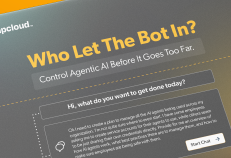The rise of autonomous AI agents is undeniably changing the cybersecurity landscape. These agents, acting with increasing autonomy, introduce a crucial new element to our threat models. Cybersecurity leaders are right to enforce a new framework that ensures the agent remains an asset and not a liability.
The consensus is clear: we must extend Zero Trust principles to every AI agent, demanding verification, defining scope, and mandating continuous control. This concept of Agentic Zero Trust is essential to prevent scenarios where a well-meaning agent, granted broad privileges, could be manipulated into misusing its access. We therefore must enforce three core mandates for AI security: discovery (identifying where and how various forms of agentic tooling and infrastructure has been introduced into the organization), containment (ensuring least privilege access in-between agentic services and infrastructure) and alignment (guaranteeing the agent’s actions match its intended purpose).
However, as this discussion moves from theory to practice, a critical disconnect is emerging in the industry: the solutions being presented for Agentic Zero Trust are often so complex and resource-intensive that they remain out of reach for the majority of organizations. Additionally, these solutions neglect the need to appropriately involve humans into the loop to approve and provide continuous observation of the AI-driven actions.
For many IT and security teams, implementing the dynamic identity and governance required for every agent sounds less like a strategic initiative and more like a crushing security overhaul. In today’s lean operating environment, complexity is the greatest obstacle to robust security.
Where Platform Complexity Fails the Majority
Current leading proposals for securing AI agents frequently require deep integration within a single, proprietary vendor platform. While this may suit a consolidated enterprise, it ignores the reality of the modern IT environment: the vast majority of organizations rely on best-of-breed tools, multi-cloud services, and a mix of operating systems (Mac, Windows, Linux).
When an Agentic Zero Trust solution requires stitching together multiple proprietary tools to establish identity, scope, and governance, it introduces several critical hurdles:
- The resource barrier: It necessitates dedicated specialists and significant capital investment—resources that are simply unavailable to most mid-market and growing enterprises. Security should not be a budget luxury.
- The fragmentation trap: AI agents don’t respect vendor boundaries. If the Identity and Access Management (IAM) solution is locked into one ecosystem, governance breaks down the moment an agent needs to access data or perform a function in a multi-cloud or third-party application. This lack of unified control is what enables unguided workflows and ungoverned assets.
- The adoption bottleneck: If governance is cumbersome and requires a complete infrastructure re-platform, IT teams will inevitably slow down AI adoption or, worse, bypass security protocols to keep pace with business demands.
If the path to securing AI requires an extensive and complicated rebuild of your entire stack, organizations will ultimately fail to meet necessary security standards.
JumpCloud’s Vision: The Accessible Path to Agentic Identity
The foundational requirements for securing AI agents are non-negotiable: every agent needs a verified identity and owner, a defined scope, and continuous monitoring.
The difference isn’t the “what,” it’s the “how.”
Agentic Zero Trust must be built as a feature of your existing, consolidated access control, not as an entirely new project. The solution must be:
- Simple and unified: You need one directory platform that can provision, manage, and audit both human and non-human identities (like AI agents and Workload Identities) across all your diverse endpoints, infrastructure, and applications.
- Flexible and open: Your identity layer must be vendor-neutral and extensible. The policy for an agent running on a Linux server in AWS should be managed by the same console and the same team as the policy for an agent running in a third-party application or a Windows environment.
- Built for the reality of IT: The framework for assigning an ID, defining scope, and enabling monitoring must be manageable by a lean IT team. The complexity must be absorbed by the platform, not forced onto the security staff.
JumpCloud’s vision is an open cloud directory that abstracts away this complexity. We provide a single, unified foundation for identity and access management, empowering organizations to secure every employee, every device, and—crucially—every new AI agent, without the burden of an extensive security overhaul.
The future of AI security is accessible, simple, and unified.





